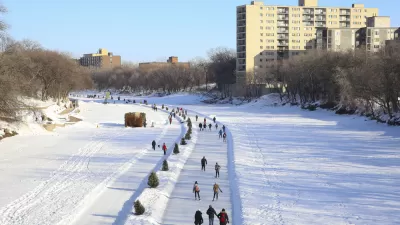"It's too cold to walk here" is often the response to the subject of livability in northern climes. Hazel Borys hails from the third coldest city of its size on earth and talks walkable winter cities.

"Walkability mitigates the most extreme climates by providing interesting places to warm up, linger, and connect. And plenty of options about how and where to turn around and circle back."
Northern cities tend to go after big silver bullets for making their cities appealing in the winter, to compete with the Sun Belt. These bullets are generally set in the city center, and are regional draws to get people to drive somewhere and then spend time outside. However, the greatest parts of walkable winter cities aren’t about the headliners, but rather the openers. And those openers tend to be enabled in policy but not in legality.
"Legalizing the useful walk, outdoor rooms, short blocks, and play sheds are the first steps toward a walkable winter city, as well as allowing us to live in season year round. These urban forms are available only by negotiation and not by right for most of North America."
"While Canadian cities offer up so many great ideas about embracing winter, last week’s Maclean’s headlined, 'We’ve become a nation of winter wusses.' This extensive piece has many inescapable points about how Canadians avoid the outdoors in winter, where in the past we used to pride ourselves on being the land of ice and snow. I think this shift is due mainly to recent suburban growth patterns."

Carnival de Québec, Québec City, Québec. CreativeCommons ShareAlike License with Attribution: flickr user Jamie McCaffrey.
FULL STORY: Walkable Winter Cities

Alabama: Trump Terminates Settlements for Black Communities Harmed By Raw Sewage
Trump deemed the landmark civil rights agreement “illegal DEI and environmental justice policy.”

Planetizen Federal Action Tracker
A weekly monitor of how Trump’s orders and actions are impacting planners and planning in America.

Why Should We Subsidize Public Transportation?
Many public transit agencies face financial stress due to rising costs, declining fare revenue, and declining subsidies. Transit advocates must provide a strong business case for increasing public transit funding.

Understanding Road Diets
An explainer from Momentum highlights the advantages of reducing vehicle lanes in favor of more bike, transit, and pedestrian infrastructure.

New California Law Regulates Warehouse Pollution
A new law tightens building and emissions regulations for large distribution warehouses to mitigate air pollution and traffic in surrounding communities.

Phoenix Announces Opening Date for Light Rail Extension
The South Central extension will connect South Phoenix to downtown and other major hubs starting on June 7.
Urban Design for Planners 1: Software Tools
This six-course series explores essential urban design concepts using open source software and equips planners with the tools they need to participate fully in the urban design process.
Planning for Universal Design
Learn the tools for implementing Universal Design in planning regulations.
Caltrans
Smith Gee Studio
Institute for Housing and Urban Development Studies (IHS)
City of Grandview
Harvard GSD Executive Education
Toledo-Lucas County Plan Commissions
Salt Lake City
NYU Wagner Graduate School of Public Service




























